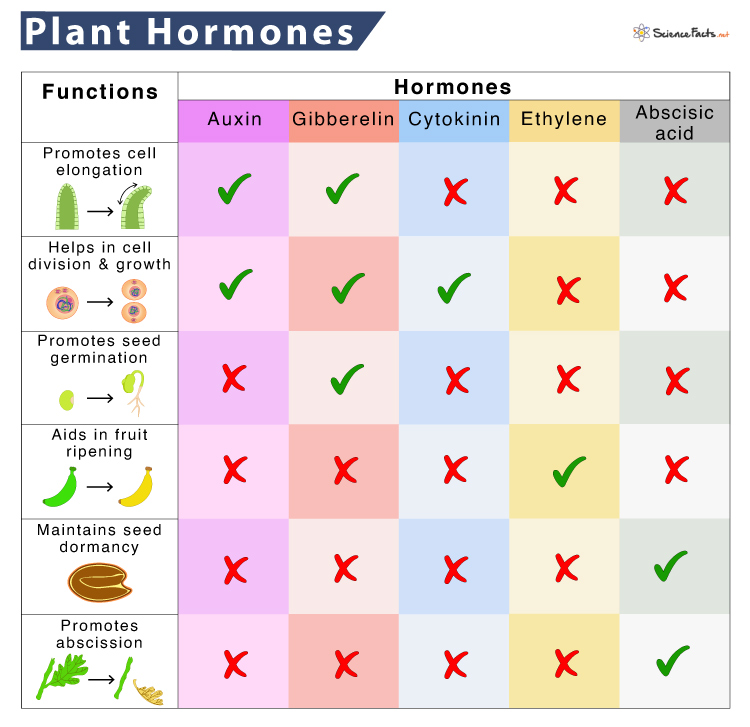Plant Hormones
Plant hormones or phytohormones are chemical compounds found in low quantities in plants and also in algae. They control their overall growth and development, reproductive processes, environmental responses, and even death. Thus, they are also called plant growth regulators (PGRs). Sometimes PGRs are also synthesized artificially.
The term ‘phytohormone’ was coined by Dutch biologist FW Went and American microbiologist KV Thimann in 1937.
Where are Plant Hormones Produced
Every plant cell can synthesize hormones. They are typically produced from the meristems (the region of active growth) before cells fully differentiate. After production, the hormones are either transported to other parts of the plant for immediate effect or stored in cells for future use.
Classification of Plant Hormones with Their Functions
PGRs can be growth promoters or growth inhibitors. There are five major types of PGRs in plants.
1) Auxins
‘Auxin’ is derived from the Greek term ‘Auxein,’ meaning to grow. They were the first group of plant growth hormones discovered. Auxin is mainly found in the tips of shoots and roots of plants, although they migrate to other parts for further action.
Indole-3-acetic acid (IAA) is a naturally produced auxin found in plants. Whereas 2,4-dichloro-phenoxy acetic acid (2,4-D), naphthalene acetic acid (NAA), and indole butyric acid (IBA) are some synthetically prepared auxins.
Functions
- Promoting cell growth and elongation
- Promoting apical dominance, that is, the apical buds grow, suppressing the lateral buds
- Inducing parthenocarpy (producing fruit without prior fertilization)
- Preventing premature fall of leaves, fruits, and flowers (abscission)
- Initiating rooting in stem cuttings and grafting
- Using as a herbicide in agriculture (example: 2,4-D)
- Helping in cell division and differentiation
- Promoting phototropism (bending towards light based on their concentration)
2) Gibberellins
They were first isolated from the fungus Gibberella fujikuroi, which promotes abnormal growth in rice plants. Later they were found to be produced by plants, controlling their growth.
Functions
- Causing stem elongation by promoting cell division and lengthening the stem internodes
- Triggering germination in dormant seeds, thus initiating plant growth
- Delaying senescence
- Producing a seedless variety of grapes and tomatoes by parthenocarpy
- Inducing maleness in cannabis
- Breaking seed dormancy
3) Cytokinins
They are naturally synthesized in plants where rapid cell division occurs, such as root apices and shoot buds. They are produced in the roots of plants that migrate to the stems and leaves for their function.
Zeatin and isopentenyl adenine are some naturally occurring cytokinins. In contrast, kinetin and benzyl adenine are synthetically prepared.
Functions
- Promoting lateral and adventitious shoot growth and development
- Suppressing apical dominance induced by auxin
- Promoting cell division, precisely the step of cytokinesis
4) Ethylene
It is a gaseous plant inhibitor in ripened fruits and tissues undergoing senescence. Ethylene helps plants to survive stress and is also widely used in agriculture.
Functions
- Promoting fruit ripening
- Inducing senescence
- Promoting abscission of leaves, flowers, and fruits
- Helping in the rapid elongation of petioles and internodes
- Breaking seed dormancy
- Controlling epinasty
- Promoting femaleness in monoecious plants
5) Abscisic Acid
It is another hormone that helps plants to cope with stress. Lack of moisture induces stomata closing of stomata thus preventing water loss by transpiration. Abscisic acid is another plant growth inhibitor apart from ethylene.
Functions
- Inducing seed dormancy
- Controlling the closing of stomata
- Inhibiting plant growth and development
Other Growth Hormones in Plants
Apart from the five major hormones, some other phytohormones also modify plant growth and inhibition. They are:
Brassinosteroids are the only steroid-based plant hormone. Brassinosteroids control cell elongation, division, gravitropism, stress resistance, and xylem differentiation and inhibit root growth and leaf abscission.
Jasmonates (JAs) are lipid-based hormones that help plants respond to stress and defend themselves from the attack of herbivores and pathogens. The most active JA in plants is jasmonic acid.
Salicylic acid (SA) is a phenol-based plant hormone initially isolated from an extract of white willow bark. SA protects plants against pathogens and responds to abiotic stress, such as drought, extreme temperatures, heavy metals, and osmotic stress. They are also found to influence seed germination, cell growth, respiration, stomatal closure, gene expression, and response to biotic and abiotic stress.
FAQs
Ans. The main differences between animal and plant hormones are:
1. Plant hormones are simple organic substances, whereas animal hormones are complex.
2. Plant hormones diffuse through xylem, phloem, and cell-to-cell via plasmodesmata, while animal hormones diffuse through the blood.
3. No specific organs produce plant hormones, whereas animal hormones are produced in specific endocrine glands.
-
References
Article was last reviewed on Thursday, February 2, 2023





The information is clear and useful
It’s helpful